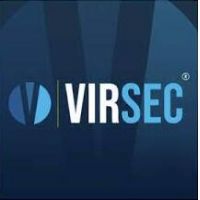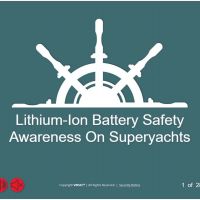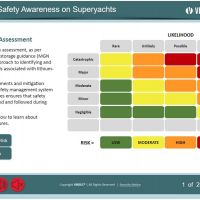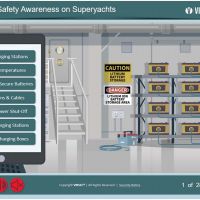Lithium-Ion Battery Safety Awareness
Lithium-Ion Battery Safety Awareness for Superyachts Fully Online Maritime Safety Training (ABS Approved)
Online Course
Course Introduction
- Lithium-ion batteries are becoming increasingly common in everyday items such as smartphones, laptops, and electric vehicles. They are also found on yachts, in power tools, remote controls, UPS, servers, personal watercraft, and tenders. Despite their many benefits, these batteries can also present significant dangers. Tailored specifically for yacht crew, officers, captains, and yacht managers, the Lithium-ion Battery Safety Awareness on Superyachts course helps Learners identify and implement suitable Li-ion fire prevention measures and considerations for responding to battery-related emergencies.
Course Features
- Course Tailored for a Yachting Audience
- The Course is Delivered Entirely Online
- Incorporates Real-World Examples
- Flexible Duration – Take at Your own Pace
- Follows a Comprehensive Course Outline
- Adheres to Regulatory Compliance
- The Course Instructs a Preventative Focus
- The Course Promotes a Safety Culture
Course Structure
About This Course
- Lithium-ion battery Safety Awareness on Superyachts is essential for all yacht crew, staff and shoreside managers of yachts that carry Lithium-ion battery-powered tenders, toys, and equipment. Entirely online, the course consists of eight short lessons that provide an in-depth study of the electrochemistry and hazards of Li-ion batteries. The philosophy underpinning this course is that prevention is better than a cure, and the course sets out best practices that can be easily implemented to mitigate any risks associated with Li-ion technology.
- This course is delivered in Partnership with Seascope France.
Who Should Take This Course
- This course is ideal for anyone involved in yacht operations who wishes to improve their knowledge of Li-ion battery safety and is specifically helpful for:
- Superyacht crew who use Li-ion battery-operated equipment.
- Competent Persons responsible for battery charging operations.
- Safety Officers and Emergency Response Teams.
- Yacht Captains and Officers who must provide confident leadership in implementing safe operating procedures for Li-ion batteries.
- Yacht Managers who must manage and document their safety culture for Li-ion batteries.
Li-ion Competent Person – MGN 681
- In their recent MGN 681, the UK’s Maritime and Coastguard Agency introduced the requirement that competent persons undertake battery charging operations. Drawing from the UK’s Code of Safe Working Practices and MGN 681, this course helps define the role and duties of this person when working with Li-ion batteries. The course will provide the Learner with the detailed knowledge required to safely conduct battery charging operations, identify hazardous or suspect batteries and recognise the necessary steps to mitigate the risk until these batteries are removed from the yacht.
Course Learning Outcomes
- Selected learning outcomes of this course include:
- Identifying where lithium-ion batteries may be encountered on yachts.
- Understanding the basic electrochemical processes of lithium-ion batteries
- Understanding the requirements for identifying hazards on yachts.
- Appreciating the toxic and explosive gases emitted from Li-ion batteries.
- Understanding the hazards of thermal runaway and battery fire.
- Recognising the challenges of responding to a thermal runaway event.
- Recognising the suitability of water-based fire suppression systems for battery fires.
- Introducing specialist equipment for containing and suppressing Li-ion fires.
- Identifying battery abuse conditions and hazardous battery defects.
- Appreciating their requirements for battery stowage compartments.
- Understanding the requirements for battery charging stations.
- Appreciating the knowledge required of the Competent Person overseeing battery charging operations.
Compliances
1. Compliance with ISM Code
- ISM Code 6.3 mandates yacht managers to establish procedures for personnel, especially those in safety and environmental roles, ensuring proper familiarisation with their duties. Our course addresses this by offering comprehensive lithium-ion battery safety training, showcasing a commitment to fulfilling ISM Code obligations and keeping personnel updated on safety protocols.
2. Meeting ISM Code 6.5 Requirements
- ISM Code 6.5 stresses the importance of identifying and providing necessary training to support safety management systems. The “Lithium-ion Battery Safety Awareness for Superyachts” course aligns with this mandate, offering in-depth insights into lithium-ion battery safety to ensure all personnel have essential training for safe superyacht operations.
3. STCW Convention Regulation I/14 – 5 Compliance
- STCW Convention Regulation I/14 – 5 highlights the need for companies to familiarise seafarers with their duties, ship arrangements, equipment, and relevant procedures. Our course surpasses theoretical frameworks by providing practical knowledge crucial for routine and emergency situations involving lithium-ion batteries, empowering yacht managers to enhance crew competency in line with the STCW Convention.
Useful Information
Subjects
- The development of Li-ion battery technology
- How Li-ion batteries function
- Where Li-ion batteries can be found on yachts
- Recognising and preventing Li-ion battery abuse
- The statutory need for hazard identification for Li-ion batteries
- Toxic and explosive gas hazards
- Fire and thermal runaway
- Basic fire theory as applied to Li-ion battery fires
- Fixed firefighting systems on yachts
- Advanced equipment and solutions for tackling Li-ion fires
- Safe battery storage handling and disposal
- Safe battery charging practices
Course Certificate of Completion
- Upon completion of this fully online course, learners will receive a digital certificate in PDF format from VIRSEC Ltd and Seascope France. This is to demonstrate that they have successfully completed the online course and associated assessment.
Accessing the Course Certificate
- Learners will be able to download and save this certificate to their desktop or desired folder from the system. Certificates must then be printed off and signed in the space allocated for the learner in black or blue ink.






